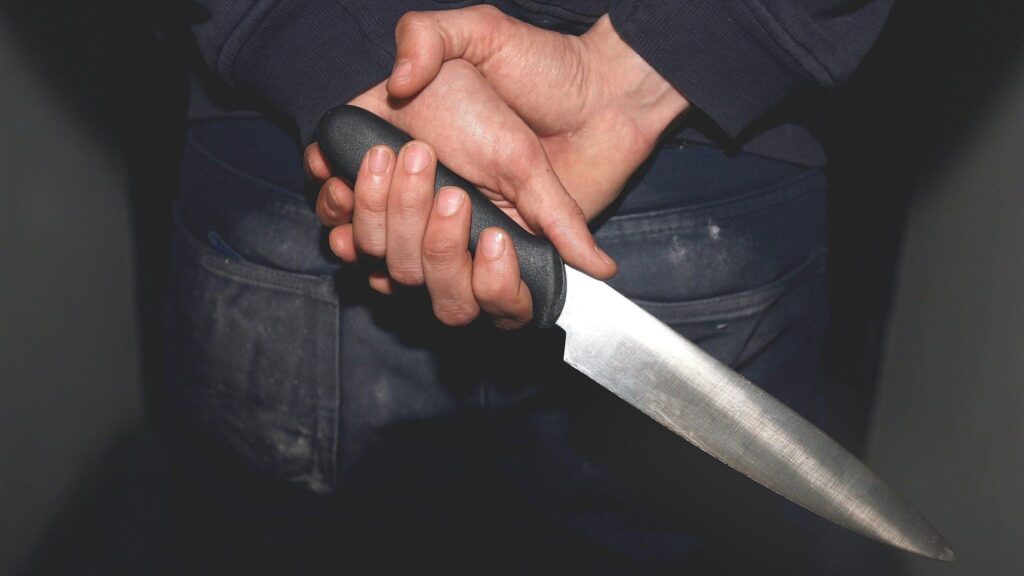It’s none of their business that you have to learn to write. Let them think you were born that way.” — Ernest Hemingway
By PJ Parrish
If you want to do it right, you need a good sharp knife.
I never believed this until recently. For decades, I struggled along with cheap knives picked up at yard sales or the sale rack at Target. Useless, these dull tools all eventually found their way to a sad dark drawer of my kitchen, leaving me dependent on one little plastic job and an old serrated steak knife to do everything I needed, from slicing a tomato to carving a turkey. (See actual evidence below).
Which leads me to my friend Peter. He was a terrific cook and believed in good knives. He had a set of Wüsthof knives, which I came to learn was the ne plus ultra of knives. He kept them sharpened, whetted and ready. When he would come to my place for dinner, he would scoff at my pitiful duo. “You can’t be a serious cook without good knives,” he said.
Peter left me his knives when he died last spring. They came to me in a box, gleaming and razor sharp. They frightened me. I was sure I’d slice an artery if I tried to use them.
Well, I didn’t. I came to appreciate the way the paring knife could effortlessly slice a tomato paper-thin. I loved the way the 8-inch utility knife churned through an onion. Carving a roast with the 10-inch chef’s knife was an epiphany. The right tools have made me a better cook.
Life is like this. Sometimes, you’re tempted to make do with the inferior, to take the easy route, to tackle a task with less-than. You folks out there who do carpentry or gardening know what I mean. You buy shoddy tools, you get shoddy results. Or you have to work twice as hard. Or you slice off a finger.
You can probably tell by now that this is a metaphor. As in life, as a writer you can’t get the job done with acquiring the right tools. You have to learn the craft. And here’s something you’re not going to like to hear: What tool you seem to lack, that’s the one you need the most.
Where do you find the right tools? Well, there are a million how-to books out there in the ether. Not all are good. Most are dull, and many are useless and should be stuck in a kitchen drawer. So let me suggest you start with The Kill Zone archives. Our contributors are laser-focused on practical craft advice, and a couple of us have written some pretty good how-to books. See that search box at the right top of this page? Type in what you need and you’ll find the tools.
Don’t be afraid to face your weakness. Find the right knife for the job you need done.
Are you bad at plotting? Does your story have a thicket of sub-plots obscuring the true story? Does your plot lack dramatic arcs (“What’s an arc?”) Does your middle act sag? Well, type “plot structure” in the search box. Great tips galore. Start with this one from James Bell, which is a basic lesson in why plot and character go hand in hand. Trouble coming up with a great ending? Debbie has it down. Type in sub-plots, or three-act structure, layering scenes or chapter transitions and you’ll find more knives.
Are your characters lacking? Are they stereotyped, unbelievable, wooden or one-dimensional? Every great story begins and ends with great characters. If this is your weakness, find the tools to help. Start with this post from Laura Benedict. Need to learn about motivation? Type in “man in the mirror” or “What does your character want?”
Does description leave you cold? We can’t all be Elmore Leonard. Most of us need at least a little descriptions to make our readers care. I love description so whenever my sister and I got to this, she’d shovel the football to me. Or she’d send me back a chapter she had worked on with big read capitals saying: INSERT DESCRIPTION OF MANSION HERE. I finally forced her to do it herself so she could learn. And she did. Start with this post for some great tips.
Stymied about your setting? You can’t tell a story without creating a world. Setting is, to my mind, one of the most neglected aspects of craft that I see in our First Page Critique submissions. If you struggle with this, check out Terry’s guide here. Or read Jordan’s inspiring take.
Is your dialogue tone-deaf? Dialogue is action. Dialogue is sleight of ear. Dialogue is hard to get right. It might be the hardest writing craft to master. Here’s a terrific primer from emeritus TKZer Jodie Renner to start with. What point of view works best for your story? Let John Gilstrap clarify things here. Should you use a dialect? Read this first. Does your dialogue sound fake? Try this knife.
One last piece of advice. Knives get dull. Even the really good German ones. You have to get them professionally sharpened, at least every couple months. I go to Precision Sharpening & Key Shop where Jeff (that’s him and Bird at left) keeps me sharp. Not sure where the metaphor is here, other than to say that even old dogs like me — even the most experienced writers, and especially the well-published — need to keep their craft honed. Or they lose their edge. And as anyone can tell you, when you lose your edge, you lose your readers. And now, I am off to pick up my knives from Jeff. Stay sharp, my friends.



